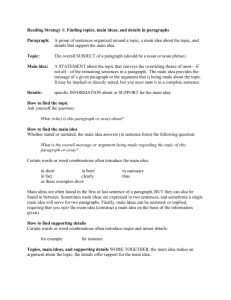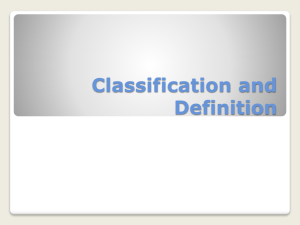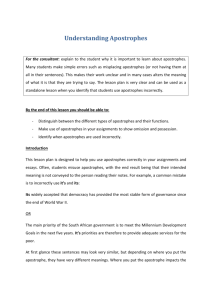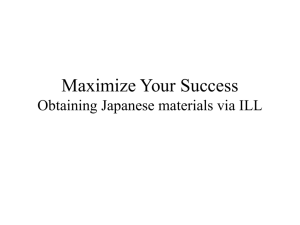The apostrophe
advertisement
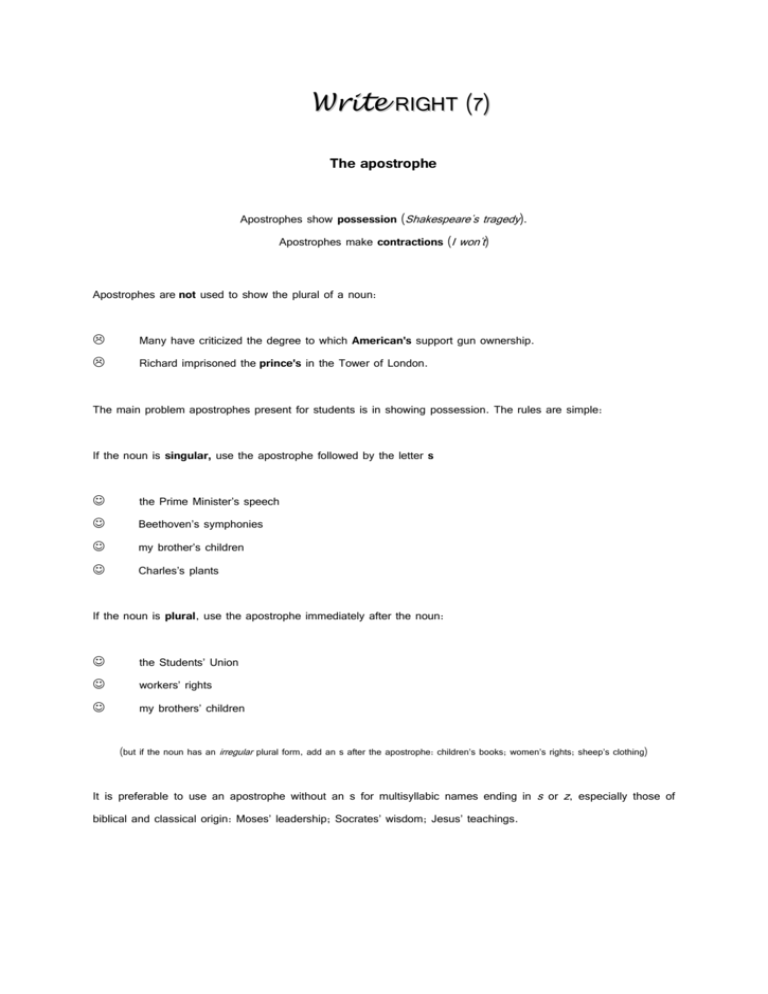
Write RIGHT (7) The apostrophe Apostrophes show possession (Shakespeare's tragedy). Apostrophes make contractions (I won't) Apostrophes are not used to show the plural of a noun: Many have criticized the degree to which American's support gun ownership. Richard imprisoned the prince's in the Tower of London. The main problem apostrophes present for students is in showing possession. The rules are simple: If the noun is singular, use the apostrophe followed by the letter s the Prime Minister’s speech Beethoven’s symphonies my brother’s children Charles’s plants If the noun is plural, use the apostrophe immediately after the noun: the Students’ Union workers’ rights my brothers’ children (but if the noun has an irregular plural form, add an s after the apostrophe: children’s books; women’s rights; sheep’s clothing) It is preferable to use an apostrophe without an s for multisyllabic names ending in s or z, especially those of biblical and classical origin: Moses’ leadership; Socrates’ wisdom; Jesus’ teachings. Nouns ending in y produce similar confusion with regard to possession. If you want to talk about something belonging to a country, write country's, not countries. It’s and its Because apostrophes are used for possession as well as contraction, many students get confused about the distinction between it's and its. The solution here is to remember that it's is a contraction, not a possessive: It's = it is. You will never need it’s in academic writing!! It, like other pronouns (he, his; she, hers) does not need an apostrophe to show possession: The essay's comic tone clashes with it's dark subject. The essay's comic tone clashes with its dark subject You would not write: ‘John and hi’s screen.’ So, you must not write: ‘The computer and it’s screen.’ Now look at the information on the University Writing Centre website: http://www.ncl.ac.uk/students/wdc/learning/accurate/punctuation/apostrophe.htm Fit some apostrophes into these sentences! During the past few weeks a weeks worth of mail has equalled what is normally eight weeks worth. Though its now named for the street on which its located its sometimes referred to by its old name. The childrens knowledge of the apostrophe was better than anyone elses. These kinds of mistake involving apostrophes are the bane of students lives. After giving her employer four months notice of her departure, Jill received a months salary and ten pounds worth of paper clips. Lets stop at the Smiths house and greet all the Smiths. Write RIGHT Paragraphs – and how to link them in a structured argument The key building block of an essay is the paragraph. A paragraph represents a distinct logical step within the whole argument. That step may be big or little; it may take one or ten sentences to lay out—but the key is that it is one step. Each paragraph should take the reader one step forward in your argument - guiding them through your reasoning. Topic Sentences A great way to think about the relationship between paragraphing and your overall argument is to create a topic sentence at (or near) the start of each paragraph. A topic sentence states the main point of a paragraph: it is a signpost for your reader, alerting them to the most important, interpretive points in each paragraph, and therefore in the essay as a whole. Sketch out your topic sentences as you write your essay plan - when read in sequence, they will provide a sketch of the essay's argument. In academic writing, the topic sentence nearly always works best at the beginning of a paragraph so that the reader knows what to expect. Don't count on your readers to guess what your paragraph is going to be about. NOTE: The first and last paragraphs of an essay are exceptions to this rule. In both instances, readers already know you're leading up to something, and you can save the topic sentence to make a strong paragraph ending. Expanding on Topic Sentences The body of a paragraph develops and demonstrates what your topic sentences state. Here are some common patterns: Explain more fully what you mean, giving definitions or indicating distinctions. Offer details, examples, or relevant quotations (with your comments). Follow through a logical sequence, showing the connections among your ideas in a recognizable pattern such as cause and effect or comparison and contrast. Certain linking words can also be powerful tools for pulling ideas together. To signal a reinforcement of ideas: also in other words in addition for example moreover more importantly but on the other hand however instead yet in contrast although nevertheless in spite of [something] thus therefore accordingly in conclusion finally so [informal] To signal a change in ideas: To signal a conclusion: PLAN (AND TOPIC SENTENCES) FOR Q4 What do archaeologists mean by the term Romanization and is Romanization an appropriate model for understanding contact and culture change in Roman Britain? Introduction Begin with idea that Romanization introduced in late 1800s (Mommsen, Haverfield), and used in different ways since. Say what I’m going to do, and stick to it!! Essay will review key scholars ideas about Romanization – chronologically - then come to conclusion about whether its appropriate NOW Middle Makes sense to go chronologically through scholars here – basic structure Mommsen/Haverfield Give Haverfield’s 1905 definition – must start with original definition Important to look at 19th Imperial background for Haverfield – use Hingley Topic sentence: The term ‘Romanization’ was first used by the German scholar Theodore Mommsen, but the concept was more firmly developed by Francis Haverfield in 1905 Nativists African scholars – find some reading! – (use Mattingly 1997 biblio); Richard Reece – read some: can use Webster (Creolization) to talk about him as well Topic sentence: The 1970s was marked by the emergence of so-called ‘nativist’ arguments (define this)…. Millett Romanization book isn’t explicit (?odd) – use his 1997 paper and quote direct – key model for 1990s Topic sentence: Martin Millett produced two seminal studies of Romanization in the 1990s (refs) and is perhaps the best-known contemporary theorist of Romanization (and then talk about what he wrote on the topic) Later Webster – creolization; Mattingly – Dialogues and JRA paper. Think about why he doesn’t like creolization Topic sentence: since the 1990s, scholars including Mattingly (REF) and Webster (REF) have drawn on ‘‘postcolonial theory in critiquing the concept of Romanization. Conclusion I don’t think it is appropriate –but need to say why. Bigger picture: well, Ive only looked at Britain. What about elsewhere. Find out about Nicola Terrenato: his name crops up everywhere! Write RIGHT Christmas Carol exercise for next time Next time, we will be looking at ways to summarise arguments/ideas from your reading, and using these summaries in your own written work. Summarise everything that happens in Stave 4 of Christmas Carol– using less than 100 words. Please email me your summary before the next class, if you can!



